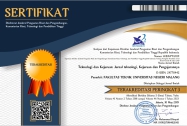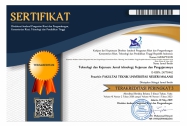Mengkombinasikan Project-Based Learning dengan STEM untuk Meningkatkan Hasil Belajar Teknikal dan Karakter Kerja Siswa SMK
Abstract
Project-based Learning (PjBL) and Science, Technology, Engineering, and Mathematics (STEM) are multidisciplinary learning. The combination of PjBL-STEM aimed to improve vocational high school students' technical learning results and working characteristics. Thus, students, after graduating, could compete in the working world. This research used secondary data review method, consisted of 17 international journals, 11 national journals, and three literature books. Based on the secondary data review, the combination of PjBL-STEM would be maximized if the teacher directly involved in the learning, where the teacher acts as inspiratory, motivator, and facilitator. Then, the PjBL-STEM learning was started from designing until result presentation that could improve the creativity and problem-solving skills. PjBL-STEM improved the hard skill in the form of technical learning results and soft skill in the form of working characteristics. Therefore, model integration of PjBL and STEM should be well-prepared. The learning strategy in each lesson must be designed well, and the assessment dimensions must be chosen thoroughly so that multidisciplinary learning could be well-realized in vocational high school in Indonesia.
Keywords
Full Text:
PDFReferences
Amamou, S. & Cheniti-belcadhi, L. (2018). Tutoring In Tutoring In Project-Based Learning. Procedia Computer Science, 126, 176–185. Apsari, Y., Lisdawati, I. & Mulyani, E. R. (2019). The Implementations of project based learning in coursebook evaluation classromm. Jurnal imiah UPT P2M STKIP Siliwangi, 6(2):187–195. Basuki & Sudjimat, D. A. (2016). Kecakapan Generik dan Pengembangannya Di Sekolah Menengah Kejuruan. Jurnal Teknologi dan Kejuruan, 39(1),75–86 Brand, B. R. (2020). Integrating Science And Engineering Practices: Outcomes From A Collaborative Professional Development. International Journal of STEM Education, 7(1), 1-13. Ceylan, S. & Ozdilek, Z. (2015). Improving a Sample Lesson Plan for Secondary Science Courses within the STEM Education. Procedia - Social and Behavioral Sciences, 177, 223–228. Elhassan, I. B. M. (2012). Multidiciplinary Curriculum to teaching English Language in Sudanese Instutions A Case Study. Journal Theory and Practice and Language Studies, 2(2), 402–406. Gale, J. (2020). Exploring Critical Components Of An Integrated STEM Curriculum: An Application Of The Innovation Implementation Framework. International Journal of STEM Education, 7(1), 1–17. Hero, L. M. & Lindfors, E. (2019). Students Learning Ecperinece in a Multidiciplinary Innovation Project. Jounral Education, 61(4), 500–522. Ismail, M. Z. (2019). The Impact of Using Stem Video in Teaching on Students’ Learning Engagement In Malaysia. International Journal of Recent Technology and Engineering, 8(2),159–165. Kementerian Pendidikan dan Kebudayaan. (2014). Materi Pelatihan Implementasi Kurikulum 2013 Tahun 2014 Badan Pengembangan Sumber Daya Manusia Pendidikan dan Kebudayaan dan Penjaminan Mutu Pendidikan. Jakarta: Badan Pengembangan Sumber Daya Manusia Pendidikan dan Kebudayaan dan Penjaminan Mutu Pendidikan. Kennedy, T. J. & Odell, M. R. L. (2014). Engaging Students in STEM Education. Science Education International, 25(3), 246–258 Kokotsaki, D., Menzies, V. & Wiggins, A. (2016). Project-based learning : A review of the literature. Jurnals Sagepub, 1(2), 1–11. Leung, A. (2020). Boundary Crossing Pedagogy In STEM Education. Internationals journal of STEM educations. International Journal of STEM Education, 9, 1–11. Musa, F. Mufti, N. & Latiif, E. (2012). Project-based Learning (PjBL): Inculcating Soft Skills in 21st Century Workplace. Procedia - Social and Behavioral Sciences, 5(9), 565–573. Painprasert, N. (2015). Factors Supporting the STEM Education Learning Management of Leader Teachers in the STEM Education Network of Thailand. The Twelfth International Conference on eLearning for Knowledge-Based Society, 2(1), 1-36. Permanasari, A. (2016). STEM Education: Inovasi dalam Pembelajaran Sains. Prosiding Seminar Nasional Pendidikan Sains, 2(1), 16–23. Pratama, H. & Prastyaningrum, I. (2016). Pengaruh Model Pembelajaran Project Based Learning Berbantuan Media Pembelajaran Pembangkit Listrik. Jurnal Penelitian fisika dan aplikasinya, 6(2), 44–50. Pratiwi, S. Cari, C. & Aminah, N. (2019). Pembelajaran IPA abad 21 dengan Literasi Sains Siswa. Jurnal Materi dan Pembelajaran Fisika, 9(1), 35–42. Rismawati, Sarwanto. & Saputro, B. (2019). Project Based learning And Guided Inquiry Learning : Students ’ Response To Rectilinear And Circular. Jurnal Ilmiah Pendidikan Fisika Al Biruni. 8(20), 187–196.
Based Learning dengan STEM ... Roberts, A. & Cantu, D. (2012). Applying STEM Instructional Strategies to Design and Technology Curriculum. PATT 26 Conference: Technology Education in the 21st Century, 1(2), 111–118. Rohmatika, R. V. (2019). Pendekatan Interdisipiner dan Multidisipliner dalam Studi Islam. Journal Al adyan, 14(1), 115–132. Saraç, H. (2018). The Effect of Science, Technology, Engineering and Mathematics-STEM Educational Practices on Students’ Learning Outcomes: A Meta-Analysis Study. Turkish Online Journal of Educational Technology - TOJET, 17(2),125–142. Sartika, D. (2019). Pentingnya Pendidikan STEM dalam Kurikulum 13. Jurnal Ilmu Sosial dan Pendidikan, 3(3), 89–93. Shahali, E. H. M. et al. (2017). STEM Learning Through Engineering Design: Impact On Middle Secondary Students’ Interest Towards STEM. Eurasia Journal of Mathematics, Science and Technology Education, 13(5),1189–1211. Siswono, T. Hartono, S. & Kohar, A. W. (2018). Effectiveness of Project Based Learning in Statistics for lower Secondary Schools. Eurasian Journal of Educational Research, 7(5), 197–210. Sudjimat, D. A. (2013). Pengembangan Kecakapan Kemampukerjaan. Malang: IKIP Malang. Sumarni, W. Wardani, S. & Gupitasari, D. N. (2016). Project Based Learning to Improve Psychomotoric Skills : A Classroom Action Research. Jurnal Pendidikan IPA Indonesia, 5(2), 157–163. Trianto, I. B. (2015). Mendesain Model Pembelajaran Inovatif. jakarta: Prenada Media Group. Trisdiono, H., Siswandari, S. & Suryani, N. (2019). Development of Multidisiplin Integrated Project- Based Learning Model To Improve Critical Thinking and Cooperation Skills. Journal JPI, 8(1), 9–20. Wijayanti, A. & Fajriyah, K. (2018). Implementasi Stem Project Based Learning Untuk Meningkatkan Keterampilan Kerja Ilmiah Mahasiswa Calon Guru SD. Jurnal Pendidikan Sains, 6(2), 62-69. Winarni, J., Zubaidah, S. & H., S. K. (2016). Stem : Apa, Mengapa, dan Bagaimana. Pros Semnas Pendidikan IPA UM, 1(1),1-4
DOI: http://dx.doi.org/10.17977/um031v43i12020p41-50
Refbacks
- There are currently no refbacks.
Copyright (c) 2020 Teknologi dan Kejuruan: Jurnal Teknologi, Kejuruan, dan Pengajarannya
Teknologi dan Kejuruan: Jurnal Teknologi, Kejuruan, dan Pengajarannya
E-ISSN 2477-0442 (online)
Contact
Faculty of Engineering, Universitas Negeri Malang (UM)
Jl. Semarang No 5 Malang 65145, Building H5, 1st Floor.
Homepage: http://journal2.um.ac.id/index.php/teknologi-kejuruan
Email: teknologikejuruan.ft@um.ac.id

This work is licensed under a Creative Commons Attribution 4.0 International License.



2.png)
1.png)
1.png)
1.png)
4.png)
1.png)
.png)

3.png)
1.png)
1.png)


